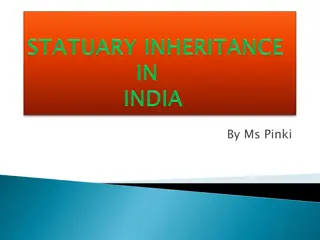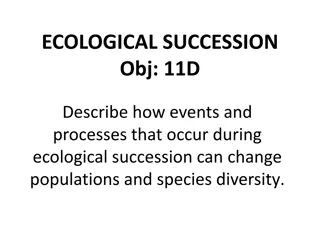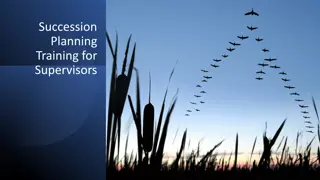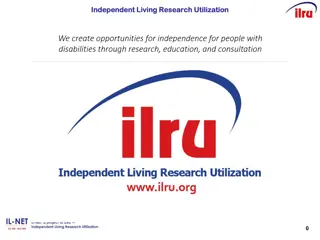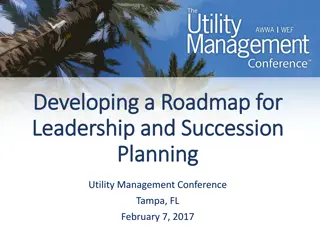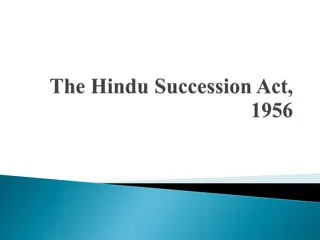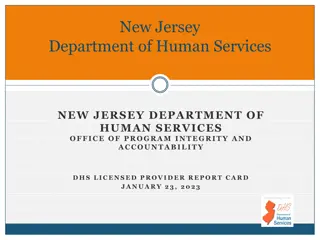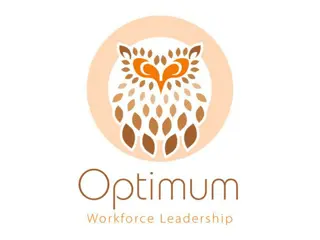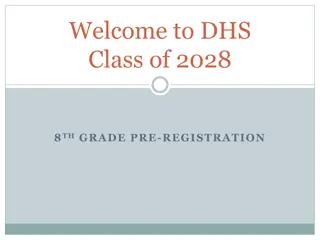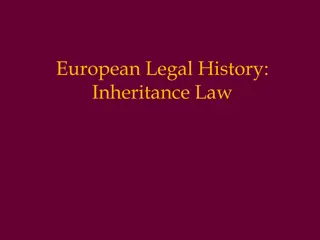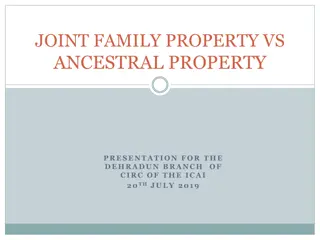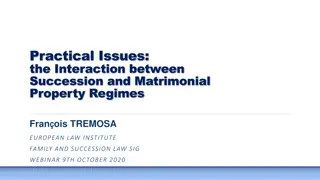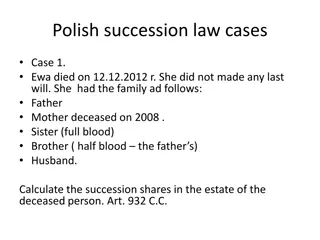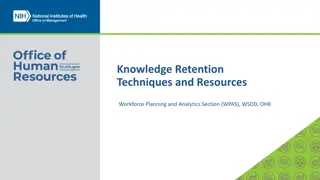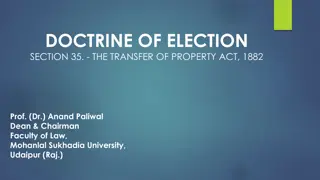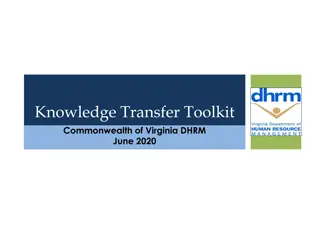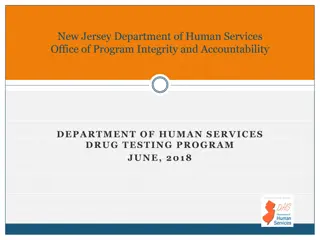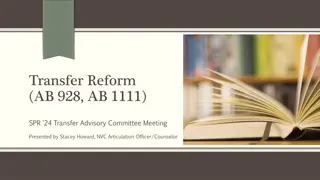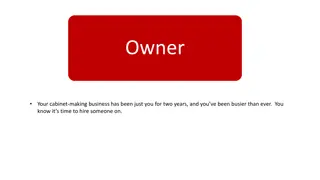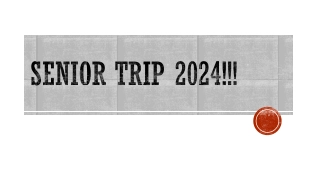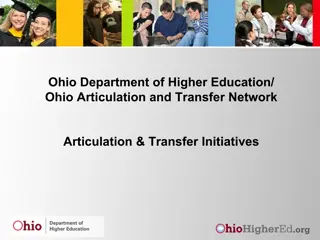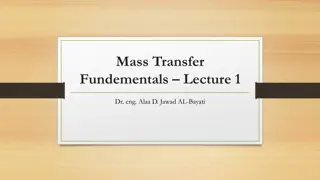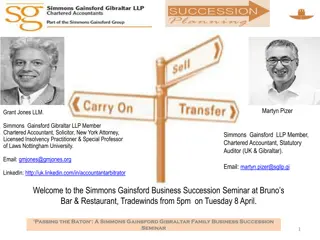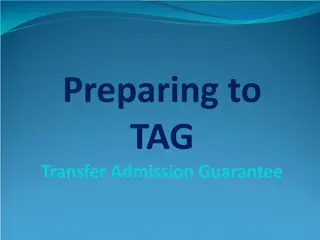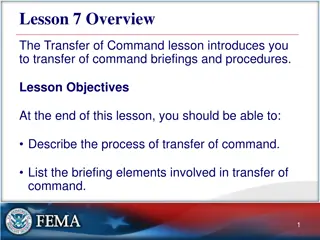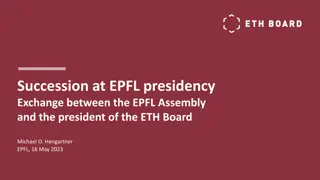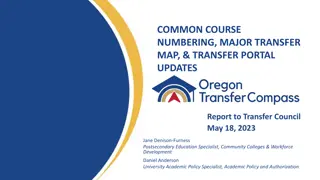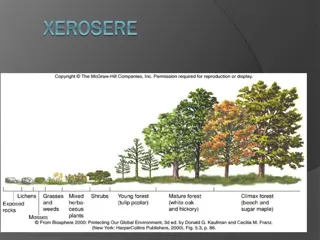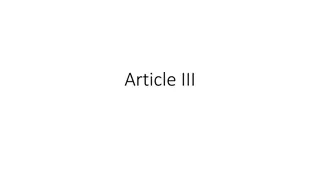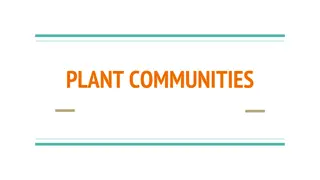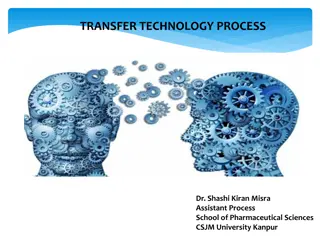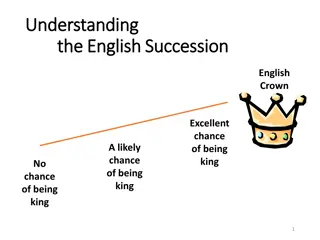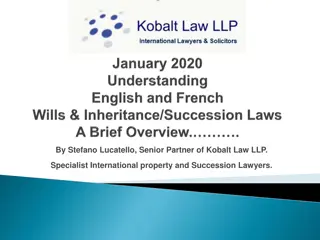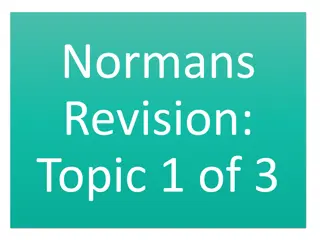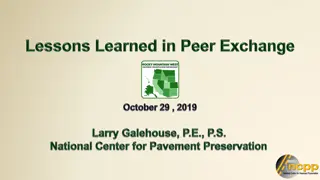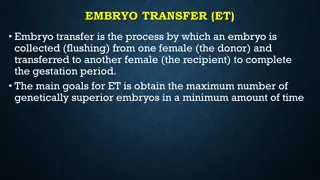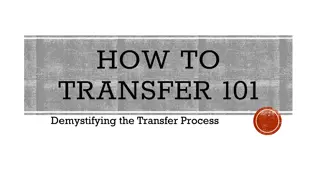Knowledge Transfer and Succession Planning Process at DHS
The knowledge transfer and succession planning process at DHS involves replicating expertise and wisdom to ensure the right people with the right skills are in place for current and future roles. This process maximizes business continuity and flexibility to meet client needs, aiming for maximum potential for individuals and organizations. The plan includes identifying critical positions, developing skills, and monitoring progress.
Download Presentation

Please find below an Image/Link to download the presentation.
The content on the website is provided AS IS for your information and personal use only. It may not be sold, licensed, or shared on other websites without obtaining consent from the author. Download presentation by click this link. If you encounter any issues during the download, it is possible that the publisher has removed the file from their server.
E N D
Presentation Transcript
Knowledge Transfer / Succession Planning Process DHS August 2018 Steve Hastings 1
The System / The Relationships Continuity & Succession Planning Workforce Planning Position Clinical Specialist How long until employee could do role: - Ready < 6 months - Ready 6-12 months How long until employee could do role: - Ready < 6 months - Ready 6-12 months - Ready 1-2 years - Ready 1-2 years - Ready > 2 years How long until employee could do role: - Ready < 6 months - Ready 6-12 months - Ready 1-2 years - Ready > 2 years - Ready > 2 years Ready < 6 months Ready 1-2 years Ready 6 - 12 months clinical trial management Maximizing Workforce Capability & Potential procedural screening device ta knowledge device tf knowledge site management site training Comments 4 8 8 logistics Name Employee 1 Employee 2 Employee 3 10 8 9 9 6 1 8 9 8 3 5 3 10 8 8 2 3 1 Employee 4 Employee 5 Employee 6 Employee 7 Employee 8 Client Outcomes Employee 9 Employee 10 Employee 11 Organization Knowledge Transfer Employee Development Skill Sequence Test Date Resources Questions 1, 2, 3, 4 1, 3, 3, 8 3, 4, 7, 8, 14 Write a . Design a Build a relationship with Lead meeting Troubleshoot 1 2 3 May 10 May 17 May 19 Specific documentation at location Formal training date Name of mentor 4 5 1, 2, 9 2, 5, 7, 14, 20 May 25 May 28 Specific template Samples at this location 2
Knowledge Transfer / Succession Planning Through a Repeatable Processes & Tools Replicating the expertise, wisdom and knowledge of critical professionals into the heads and hands of their coworkers to ensure Right people, Right place, Right time, Right skills to Lead and do the work now, and in the future so that our individuals and organizations are reaching their maximum potential maximizing business continuity when employee changes occur flexible and adaptable to meet our clients needs Step3 Step2 Step1 Knowledge Transfer Matrix Skill Development Plan Knowledge Transfer Workshop TBD Position Clinical Specialist Skill Sequence Test Date Resources How long until employee could do role: - Ready < 6 months - Ready 6-12 months - Ready 1-2 years - Ready 1-2 years - Ready > 2 years How long until employee could do role: - Ready < 6 months - Ready 6-12 months - Ready 1-2 years - Ready > 2 years - Ready > 2 years Ready < 6 months Ready 1-2 years Ready 6 - 12 months How long until employee could do role: - Ready < 6 months - Ready 6-12 months clinical trial management Questions 1, 2, 3, 4 1, 3, 3, 8 3, 4, 7, 8, 14 procedural screening device ta knowledge device tf knowledge Write a . Design a Build a relationship with Lead meeting Troubleshoot 1 2 3 May 10 May 17 May 19 Specific documentation at location Formal training date Name of mentor site management site training Comments 4 8 8 logistics 4 5 1, 2, 9 2, 5, 7, 14, 20 May 25 May 28 Specific template Samples at this location Name Employee 1 Employee 2 Employee 3 10 8 9 9 6 1 8 9 8 3 5 3 10 8 8 2 3 1 Employee 4 Employee 5 Employee 6 Employee 7 Employee 8 Employee 9 Employee 10 Employee 11 Employee Development Plan Metric: 1) Each organization identify 3 positions that business continuity is at greatest risk 2) Determine level of existing knowledge coverage 3) Set 6 to 12 month goal of having at least 3 other members of the organization to be >90% capable of doing all knowledge areas 4) Monitors metric in the QBR DRAFT Model adapted from Knowledge Transfer Process material from the Steve Trautman Company 3
Business Issues Developing Leaders Executive succession High potential acceleration Evaluating and bridging capability gaps New business needs (e.g., budgeting) Retirements and skill shortages Process and skill evolution Leadership skill evolution (Leadership Model) Strengthening staff development Job transitions (internal and external) Retention Dispersed/diverse employees On-boarding 4
Benefits to be gained / risks avoided What Benefits will be gained? What Risks will be Avoided? Development of the workforce needed to accomplish our strategies Engagement and retention of Millennials through increased career opportunities Identifying best practices and creating consistency (e.g. working with offshore partners) Business continuity when employee departure occurs (for whatever reason) Reduce number of employees with unique siloe d knowledge Minimizing the knowledge loss impact of retiring workers Load leveling to reduce overreliance on one expert = Talent Risk Mitigation Prepare for emergency talent loss scenarios Not being prepared for management changes Model adapted from Knowledge Transfer Process material from the Steve Trautman Company 5
Knowledge Transfer Matrix: Critical Positions Step 1 Step 1: List all the key positions in the organization Step 2: Identify from the list those positions that business continuity is at greatest risk (high, medium, low) Step 3: Identify position vulnerability Step 4: Select one position at a time to build Knowledge Transfer Matrix Position Vulnerability - Open < 1 year - Open 1-3 years - Open 3 + years varied varied varied Level of Business Continuity Risk (high, medium, low) High High High Current Incumbent Mary Bill & Shannon Larry & Jim Priority 1 2 3 4 5 Position Ocean and Marine Program Manager Deputy Directors Watershed Managers 7
Knowledge Transfer Matrix Step 2 To assess risk, start with listing all of the knowledge silos across the top. Silos are: Business Process/ Technical Skills Tools Processes Job functions Regulations Leadership Skills Accountability Communication Empowerment Leadership Competencies Business Process/Technical Skills Develop HQ Fish Budgets The Process for Setting Up Budgets at HQ Legislative Training from the HQ Leadership Level Supervise Marine and Columbia River Programs Develop long and short term harvest management & conservation plans Lead ODFW efforts on the Pacific Fishery Management Council and Pacific Salmon Commission Strategic thinking Communication skills (written and verbal) Establish functional productive relationships Operational fluency Note: If you have a Skills Versatility Matrix developed, cross reference to ensure you are capturing the key components of the position Mentor and develops staff Effectively partners and supports across functional areas 8
Knowledge Transfer Matrix: Add the People/Team Step 3 Then add in the people you want to include in the risk assessment exercise. Organize them by team (one under each supervisor) or by job family (e.g. case workers). Whatever makes sense. 9
Knowledge Transfer Matrix: Evaluate each employee on competency Step 4 For each silo, rate on a scale the employee s current level of perceived proficiency Note: If you have a Skills Versatility Matrix developed, look at those fully capable for a knowledge silo as possible mentors 10
Knowledge Transfer Matrix: Duration To Ready Step 5 Assess duration to readiness: Employee for entire position Knowledge silo with at least 1 or 2 mentors 11
Knowledge Transfer Matrix- Greatest Risk Areas Step 6 Identify greatest risk competency areas Shade cell in red of most critical/lowest scoring competencies 12
Assess Interest Step 7 Discuss desire to develop the identified employee to determine interest for succession Discuss desire to develop an employee with a critical knowledge gap to determine interest If employee is supportive, begin development plan process 13
Create Knowledge Transfer Plans / Skill Development Plan Step 8 To be expanded Employee Name: Skill Write a . Design a Build a relationship with Lead meeting Troubleshoot Sequence Test Questions 1 1, 2, 3, 4 2 1, 3, 3, 8 3 3, 4, 7, 8, 14 Date May 10 May 17 May 19 Resources Specific documentation at location Formal training date Name of mentor 4 5 1, 2, 9 2, 5, 7, 14, 20 May 25 May 28 Specific template Samples at this location Model adapted from Knowledge Transfer Process material from the Steve Trautman Company 14
The Plan M 9 M 10 M 11 M 12 M 1 M 2 M 3 M 4 M 5 M 6 M 7 M 8 Identify competencies X X Identify the employees X X Assess the employees X X Duration to ready X X Determine competency risk areas X X Determine employees desired to develop X X Discuss interest with identified employees X Development to plan X X X X X X X X X Evaluate X X X X Reassess plan X 15
Next Steps Team to determine common competencies (Month 1/2) Technical Leadership Facilitated by XXXXX Each organization will identify the 3 to 5 key organization specific competencies (Month 1/2) Facilitated by XXXXX Check in on progress against plan at (XXX) team meeting 16
Appendix 17
Skill Development Plan Assessment Questions One reason we value experts in any organization is for their ability to do great work. We also value them because they are able to answer the questions we have for them with the right answer. We all know how great it is to talk with an expert who can quickly decode a problem from their wealth of experience. The difference between experts and apprentices (non-experts) is that they either can t answer our questions or they may even give us the wrong answer. I know I m stating the obvious but I m doing so to make a point: one clear gap between experts and non-experts is their ability to provide good answers to tough questions. Steve Trautman - blog 18
Skill Development Plan Assessment Questions Be sure your apprentice is able to explain: 1. 2. 3. 4. 5. 6. 7. 8. 9. 10. The 3 best practices for this topic 11. Where to find resources (documents, experts, samples, websites, etc.) 12. How to choose between x and y 13. How to recognize quality work 14. What standards or rules exist and how rigorously they are applied 15. How the skill relates to the overall job 16. The 3 greatest potential safety hazards on this job 17. The 3 ways to shortcut safety procedures and their consequences (so they can be avoided) 18. What to look for, listen for, feel, or smell 19. The relevant historical issues to consider 20. The characteristics of a normal state and the most common characteristics of abnormal state The most common vocabulary words, acronyms, and terms The number of steps in the process and why each is important The top 3 things that often go wrong when someone is learning this skill The relationship between x and y How to troubleshoot the three most common problems The first 3 things to check when troubleshooting anything Who is/should be involved/affected/consulted and why How to identify and define a problem vs. a crisis in this area How to escalate a problem or crisis in this area to get additional help Model adapted from Knowledge Transfer Process material from the Steve Trautman Company 19
Knowledge Transfer / Succession Planning Excel Template & Competency Matrix Knowledge Transfer Template Competency Matrix option 20


